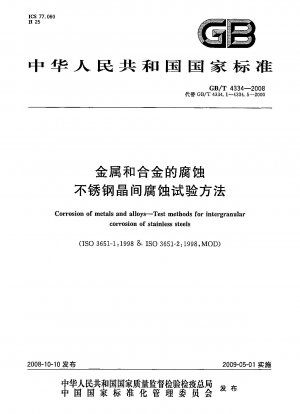GB/T 4334-2008
Corrosion of metals and alloys.Test methods for intergranular corrosion of stainless steels (English Version)
- Standard No.
- GB/T 4334-2008
- Language
- Chinese, Available in English version
- Release Date
- 2008
- Published By
- General Administration of Quality Supervision, Inspection and Quarantine of the People‘s Republic of China
- Status
- 2020-11
- Replace By
- GB/T 4334-2020
- Latest
- GB/T 4334-2020
- Replace
- GB/T 4334.5-2000 GB/T 4334.4-2000 GB/T 4334.3-2000 GB/T 4334.2-2000 GB/T 4334.1-2000
- Scope
- This standard specifies the sample, test solution, test equipment, test conditions and procedures, test result evaluation and test report of stainless steel intergranular corrosion test method. This standard applies to the inspection of stainless steel intergranular corrosion. Including the following test methods: a) Method A - 10% oxalic acid etching test method for stainless steel. It is suitable for the screening test of intergranular corrosion of austenitic stainless steel. After the sample is electrolytically etched in 10% oxalic acid solution, observe the metallographic structure of the etched surface under a microscope to determine whether it is necessary to carry out methods B, C, and Method D, method E and other long-term hot acid tests. It can also be used as an independent inspection method for intergranular corrosion under the condition that the structure and equipment under test are not allowed to be damaged. b) Method B—Sulfuric acid-ferric sulfate corrosion test method for stainless steel. It is suitable for evaluating intergranular corrosion tendency by corrosion rate after boiling test of austenitic stainless steel in sulfuric acid-ferric sulfate solution. c) Method C - 65% nitric acid corrosion test method for stainless steel. It is suitable for evaluating intergranular corrosion tendency by corrosion rate after boiling test of austenitic stainless steel in 65% nitric acid solution. d) Method D—Stainless steel nitric acid-hydrofluoric acid corrosion test method. It is suitable for testing the intergranular corrosion tendency of aluminum-containing austenitic stainless steel. The intergranular corrosion tendency is determined by the ratio of the corrosion rate in 10% nitric acid and 3% hydrofluoric acid solution at a temperature of 70°C to the corrosion rate of the reference sample. e) Method E—Sulfuric acid-copper sulfate corrosion test method for stainless steel. It is suitable for inspecting austenitic and austenitic-ferritic stainless steel after boiling test in sulfuric acid-copper sulfate solution with copper shavings, and judging intergranular corrosion tendency by bending or metallographic phase.
GB/T 4334-2008 Referenced Document
- GB/T 2100 Corrosion-resistanst steel castings for general applications*, 2017-11-01 Update
- GB/T 620 Chemical reagent—Hydrofluoric acid*, 2011-05-12 Update
- GB/T 625 Chemical reagent.Sulfuric acid
- GB/T 626 Chemical reagent Nitric acid
- GB/T 655 Chemical reagent—Ammonium persulfate*, 2011-05-12 Update
- GB/T 665 Chemical reagent.Copper(Ⅱ)sulfate pentahydrate
- GB/T 8170 Rules of rounding off for numerical values & expression and judgement of limiting values
- GB/T 9854 Chemical reagent.Oxalic acid dihydrate
GB/T 4334-2008 history
- 2020 GB/T 4334-2020 Corrosion of metals and alloys-Test methods for intergranular corrosion of austenitic and ferritic-austenitic (duplex) stainless steels
- 2008 GB/T 4334-2008 Corrosion of metals and alloys.Test methods for intergranular corrosion of stainless steels
- 2000 GB/T 4334.1-2000 Method of 10 per cent oxalic acid etch test for stainless steels
